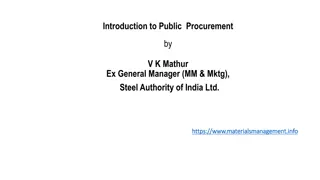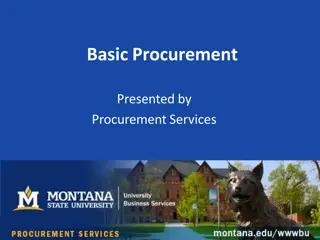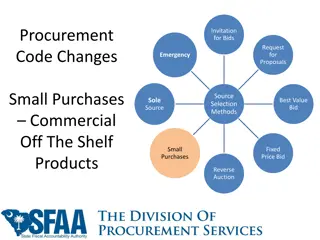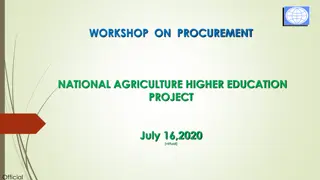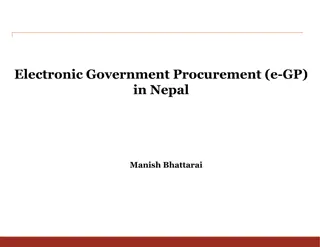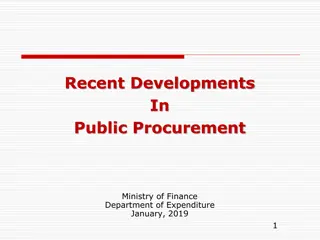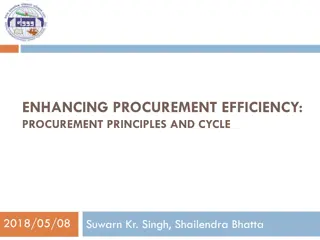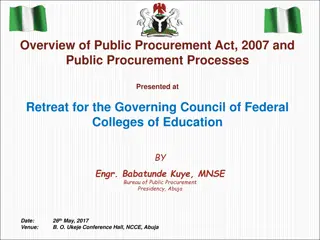
Empowering Inuit Women in Business Procurement | A Comprehensive Guide
Discover the essential aspects of procurement for Inuit women in business through this comprehensive guide. Learn about the benefits, types, process, strategies, best practices, common terms, and more to enhance your procurement knowledge and contribute to economic development. Empower yourself as an Inuit woman business owner to partake in procurement opportunities and celebrate Indigenous culture while fostering community growth.
Download Presentation

Please find below an Image/Link to download the presentation.
The content on the website is provided AS IS for your information and personal use only. It may not be sold, licensed, or shared on other websites without obtaining consent from the author. If you encounter any issues during the download, it is possible that the publisher has removed the file from their server.
You are allowed to download the files provided on this website for personal or commercial use, subject to the condition that they are used lawfully. All files are the property of their respective owners.
The content on the website is provided AS IS for your information and personal use only. It may not be sold, licensed, or shared on other websites without obtaining consent from the author.
E N D
Presentation Transcript
A GU I D E FO R I N U I T W O M E N I N BU SI N E SS PROCUREMENT 101 PROCUREMENT 101
PROCUREMENT 101 PROCUREMENT 101 Topics Covered What is procurement? Benefits of Procurement Types of Procurement Procurement Process Bidding Strategy Best Practices in Bidding Where to Look Relationship Building Supplier Development Programs Common Terms A G U I D E F O R I N U I T W O M E N I N B U S I N E S S
PROCUREMENT 101 PROCUREMENT 101 You may familiarize yourself with these terms before exploring the module or use it as a reference. Common terms Tender - a formal offer or proposal made by a supplier or contractor in response to a request for proposal (RFP) or other procurement opportunity. Bid - a proposal submitted by a supplier in response to an RFP or other procurement opportunity Solicitation - the process of requesting or seeking proposals, bids, or offers from suppliers or contractors to provide goods, services, or works for a project or procurement opportunity. Contract - a legally binding agreement between a buyer and a supplier that outlines the terms and conditions of the procurement transaction A G U I D E F O R I N U I T W O M E N I N B U S I N E S S
PROCUREMENT 101 PROCUREMENT 101 Common terms (continued) Supplier - an individual or organization that provides You may familiarize yourself with these terms before exploring the module or use it as a reference. goods, services, or works to a buyer Purchase order - a document used to authorize a procurement transaction and confirm the details of the purchase Payment terms - the agreed-upon terms for payment between the buyer and supplier Delivery date - the agreed-upon date for delivery of goods or services A G U I D E F O R I N U I T W O M E N I N B U S I N E S S
PROCUREMENT 101 PROCUREMENT 101 Common terms (continued) You may familiarize yourself with these terms before exploring the module or use it as a reference. Quality assurance - the process of ensuring that goods or services meet the specified quality standards Compliance - adherence to legal, regulatory, and ethical standards in the procurement process. A G U I D E F O R I N U I T W O M E N I N B U S I N E S S
PROCUREMENT 101 PROCUREMENT 101 Procurement for Inuit Women in Business As Inuit women business owners, you have unique opportunities to participate in business procurement and contribute to the economic development of your communities. I am celebrating my Indigenous way of life, and a part of our culture is sharing. I m sharing my way of life and I m also sharing who we are and I m also empowering who we are. And I don t think you can get any better than that bringing pride to our culture. A G U I D E F O R I N U I T W O M E N I N B U S I N E S S
PROCUREMENT 101 PROCUREMENT 101 What is Procurement? Procurement is the process of acquiring goods or services for a business or organization. As a business owner or entrepreneur, you may participate in procurement processes by applying for tenders or contracts issued by government agencies, corporations, or other organizations. If you are awarded the contract, you become a supplier. A G U I D E F O R I N U I T W O M E N I N B U S I N E S S
PROCUREMENT 101 PROCUREMENT 101 Benefits of Procurement Access a large customer base Create steady revenue streams Build your business s capacity and expertise Win contracts grow customer base increase revenue Develop a successful business proposal strategy to improve chances of winning contracts and achieving long-term success A G U I D E F O R I N U I T W O M E N I N B U S I N E S S
PROCUREMENT 101 PROCUREMENT 101 What s in a word? PROCUREMENT Describes the overall process Businesses and organizations use procurement to acquire goods and services Your business can participate in procurement as a supplier to earn a new client A G U I D E F O R I N U I T W O M E N I N B U S I N E S S
PROCUREMENT 101 PROCUREMENT 101 What s in a word? TENDER Describes the invitation to participate in procurement Like Request for Proposal (RFP) Your business can respond to a tender with a bid (an offer or proposal) A G U I D E F O R I N U I T W O M E N I N B U S I N E S S
PROCUREMENT 101 PROCUREMENT 101 What s in a word? CONTRACT Describes the agreement between your business and the client You can win contracts through the procurement process The result of a successful tender is a contract A G U I D E F O R I N U I T W O M E N I N B U S I N E S S
PROCUREMENT 101 PROCUREMENT 101 Types of Tenders 1. Open Tenders: open to all businesses that meet the criteria and can provide the goods or services required. This is the most common tender. 2. Closed Tenders: limited to a select group of pre-qualified suppliers. 3. Request for Proposals (RFPs): seeking proposals that outline how a supplier can deliver a solution to a problem. RFPs are often used for complex projects or services that require a more detailed proposal. 4. Request for Quotations (RFQs): requesting suppliers to provide quotes for specific goods or services. RFQs are often used for more straightforward purchases, such as office supplies or equipment. A G U I D E F O R I N U I T W O M E N I N B U S I N E S S
PROCUREMENT 101 PROCUREMENT 101 Types of tenders (continued) 5. Statements of Work (SOWs): a detailed description of the scope of work the government requires the supplier to perform. The SOW outlines the specific tasks, objectives, deliverables, and timelines for the project. 6. Two-Stage Tenders: These are used when the buyer is uncertain about the solution to their needs or requires input from suppliers. The first stage involves a preliminary proposal or expression of interest, followed by a second stage in which selected suppliers provide more detailed proposals. 7. Framework Agreements: These are long-term agreements between a buyer and supplier for the supply of goods or services over a set period. This allows the buyer to streamline the procurement process for ongoing needs and establish a closer relationship with a preferred supplier. A G U I D E F O R I N U I T W O M E N I N B U S I N E S S
PROCUREMENT 101 PROCUREMENT 101 Types of tenders (continued) 8. Reverse Auctions: These involve suppliers bidding against each other for the opportunity to supply goods or services to a buyer. This type of tender is often used when there is a high volume of suppliers for a particular product or service. A G U I D E F O R I N U I T W O M E N I N B U S I N E S S
PROCUREMENT 101 PROCUREMENT 101 The Procurement Process 1. IDENTIFY 2. RESEARCH 3. TENDER/ RFP/RFQ 4. EVALUATE 5. NEGOTIATE 6. MANAGING Conducting market research to identify potential suppliers Issuing a tender, request for proposal (RFP), or request for quotation (RFQ) Evaluating proposals and selecting a supplier Negotiating the contract and finalizing the terms Identifying the need for goods or services Managing the relationship with the supplier A G U I D E F O R I N U I T W O M E N I N B U S I N E S S
PROCUREMENT 101 PROCUREMENT 101 Bidding Strategy A bidding strategy is a plan that outlines how a business will prepare and submit a tender response. This can include researching the buyer, understanding their needs and requirements, and preparing a strong bid response that meets their needs. A G U I D E F O R I N U I T W O M E N I N B U S I N E S S
PROCUREMENT 101 PROCUREMENT 101 Key Considerations for Bidding Strategy When developing a Bidding strategy, consider: When developing a Bidding strategy, consider: 1. Buyer research: understanding the buyer s needs, requirements, and evaluation criteria. 2. Competitive analysis: researching competitors and set apart the business from others. 3. Pricing strategy: developing a competitive pricing strategy. 4. Bid response: preparing a high-quality response that meets the buyer s needs and requirements. A G U I D E F O R I N U I T W O M E N I N B U S I N E S S
PROCUREMENT 101 PROCUREMENT 101 Best Practices in Bidding To increase the chances of 1. Start early: allowing sufficient time for research, planning, winning contracts, businesses and preparing a quality response. should follow best practices 2. Read carefully and pay close attention to details. such as: 3. Be concise and clear: avoiding ambiguity and providing specific and relevant information. 4. Highlight differentiators: showcasing unique selling points and strengths. 5. Proofread and review: ensuring the response is accurate, professional, and meets all requirements. A G U I D E F O R I N U I T W O M E N I N B U S I N E S S
PROCUREMENT 101 PROCUREMENT 101 Where to look 1. Government portals: Check Canada Buys, Nunavut Tenders, Contract Event Opportunities website of the Government of the Northwest Territories, SEAO (Quebec), and Newfoundland & Labrador s Public Procurement Agency. Here you can find opportunities for public contracts in Canada and are a great resource for businesses looking to sell to government agencies. Tenders for all levels of government (federal, provincial, and municipal) can be found on Canada Buys. 2. Private sector portals: There are many private sector portals that list tenders for businesses, such as MERX or OpenNWT. Websites like these often have a pay-wall for full features. A G U I D E F O R I N U I T W O M E N I N B U S I N E S S
PROCUREMENT 101 PROCUREMENT 101 Where to look (continued) 3. Industry associations: Industry associations and trade groups often have resources for members to find tender opportunities within their specific industry. 4. Not-for-Profit Organizations: tenders for not-for-profits can be found on their own websites, on industry association sites, on private sector portals. Network with businesses who have worked for not-for-profits in the past. Call not-for- profits directly to inquire about opportunities or to offer your services. 5. Networking: Building relationships with potential buyers and suppliers can be a valuable way to find tender opportunities. Attending trade shows, joining industry associations, and participating in business forums are ways to connect with potential partners and learn about upcoming tenders. A G U I D E F O R I N U I T W O M E N I N B U S I N E S S
PROCUREMENT 101 PROCUREMENT 101 Where to look (continued) 6. Social media: Social media platforms like Twitter and LinkedIn can be a useful source of tender opportunities. Many government agencies and private companies use social media to promote their tender opportunities, so following these accounts can provide a stream of potential contracts. 7. Direct contact: Businesses can also reach out straight to potential buyers to express their interest in working together. This can involve sending a proposal or simply introducing the company and its capabilities. Other organizations know me, they contract me. Inuit Woman in Business A G U I D E F O R I N U I T W O M E N I N B U S I N E S S
PROCUREMENT 101 PROCUREMENT 101 Relationship Building Using available supports and building relationships is an important part to being successful in procurement. Build relationships with procurement officials Attend networking events Attend webinars to build your knowledge Seek opportunities to engage with representatives to understand procurement trends Gather feedback Expand your business networks Reach out to your network for support and advice A G U I D E F O R I N U I T W O M E N I N B U S I N E S S
PROCUREMENT 101 PROCUREMENT 101 People gravitate to people of the same. You will gravitate to other business people. Those relationships are also what will build your reputation in your work. Inuit Woman in Business A G U I D E F O R I N U I T W O M E N I N B U S I N E S S
PROCUREMENT 101 PROCUREMENT 101 Supplier Development Programs The Government of Canada offers various supplier development programs, including training seminars, 1-1 mentoring, and networking opportunities. Checkout the Events Calendar on Canada Buys MERX provides free tutorials for suppliers A G U I D E F O R I N U I T W O M E N I N B U S I N E S S
PROCUREMENT 101 PROCUREMENT 101 Where Can I Get Help? Pauktuutit has many resources available on our website: Inuit Women in Business Network Business Resources A G U I D E F O R I N U I T W O M E N I N B U S I N E S S

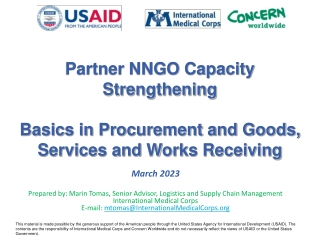

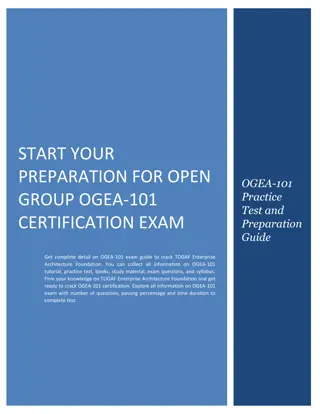
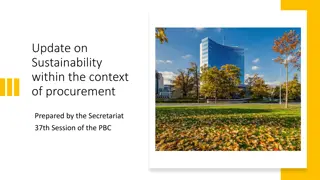

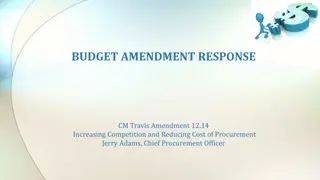
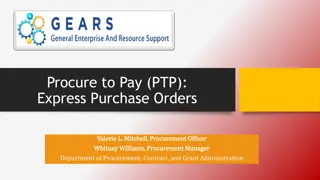
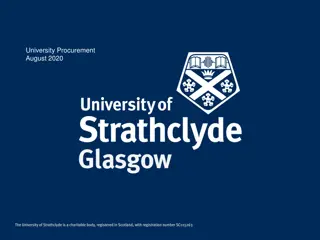
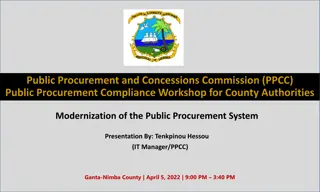
![Comprehensive Overview of Corruption Watch Submission on Public Procurement Bill [B18B-2023]](/thumb/138344/comprehensive-overview-of-corruption-watch-submission-on-public-procurement-bill-b18b-2023.jpg)
